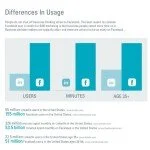How to Instantly Lose Credibility with a Bad Infographic
Recently a discussion posted in a LinkedIn group lead me to a blog article featuring an infographic that floored me in its inaccuracy and misleading conclusion. I think it is a beautiful example of how easily you can torpedo your credibility with content that isn’t well conceived and supported. This is especially true with technology buyers – both IT and business types - who insist upon relevance, logic and facts.
The offending infographic is titled “B2B Marketing: LinkedIn vs Facebook”. I think the easiest way to understand the weaknesses and downright mistakes I’m talking about is to look at it section by section.
The introduction
The infographic starts off solidly enough. It sends a clear message that we’re going to learn why LinkedIn might not be better for B2B marketing. No problems here.
“Primary Usage”
The infographic producer continues to take a neutral position, but none of this helps me understand whether or not either platform is good for a B2B marketer. It’s just filler stats and wastes an opportunity to tell me something valuable.
It would have been far more informative to tell me whether or not B2B buyers go to either network to connect with sellers, and a quick look online would have shown this data does exist.
The real story: A recent study conducted by comScore found that 68% of B2B technology buyers are open to connecting with or following a vendor on social media and 75% are ready to have a conversation with a vendor on social. Bad news for Facebook: 2X more tech buyers trust LinkedIn than other websites to connect with vendors, discuss their vendor experiences, and receive tech information.
“Differences in usage”
In this section the infographic producer makes an unsupported claim that “business people do not shut off business thinking when on Facebook”. This goes against the conventional view of Facebook, which is as a platform for personal networking. If you’re going to convince me to change my mind on something as deeply ingrained as that opinion, you’re going to have to offer me some kind of real proof.
We’re also told “the best reason to consider Facebook over LinkedIn for B2B marketing is that business people spend more time on it”. To support this claim, the content developer offers the following chart.
But the data here is misleading. The text refers to “business people” yet the image provides overall user data for both platforms. While we can assume the LinkedIn users are business people who are on the platform for business reasons, we cannot assume the Facebook users are even business people at all and we know they’re not all on there for business.
To be credible, the content provider must compare business users to business users and not include non-relevant users such as long-retired grandparents who are checking out the latest family photos.
“Why Facebook should not be overlooked”
This is certainly an issue that needs to be address in this infographic, but take a closer look at the stats. While the first data point is related to Facebook, the other two are social media in general and are not specific to Facebook. This leads me to assume the content producer can only find one piece of information to support B2B companies using Facebook.
“Increased Visibility”
And finally, the producer wants to convince us that B2B companies should market themselves on Facebook because Southwest Airline, Sprint-Nextel and UPS advertise on the SuperBowl. The creator’s argument is that such activity helps B2B marketers “optimize visibility and gain new business”.
While mass marketing specialists have long used the argument that “more eyes are better”, this argument simply doesn’t hold for B2B marketers with a tight budget. You may have noticed that the three examples used here are also B2C marketers with gigantic marketing budgets!
Conclusion
The opinion I formed when first looking at this infographic is that the producers were either a) not knowledgeable enough on the subject to realize the facts don’t support the claims or b) so desperate to communicate a message (in this case that Facebook is a better medium for B2B marketers than LinkedIn) they threw the basics of logic and persuasion out the window. Neither of these is good for credibility.
As marketers we often find ourselves emphasizing information that supports our point of view and ignoring or downplaying anything contradictory. There’s nothing inherently wrong with the practice – as long as the information you’re emphasizing actually does support your claims.
The take away from this article is this: business buyers, while human, are increasingly immune to content that looks good but contains no substance – or worse, contains inaccurate information. These buyers are on social media to solve problems and validate information they’ve acquired elsewhere. Don’t be in such a hurry to create content or to make your position heard that you fail to provide a logical argument and well-documented support. Your credibility is on the line.
Closing thought
Surprisingly, this infographic appeared on the Social Media London blog, which I regard as an authority site. I suspect it’s an oversight that won’t be allowed to happen again. But if I weren’t already familiar with them, this infographic would have caused me to mentally put them in a bucket with untrustworthy content providers.
Get the real, data-supported story on social media’s place in the IT buying process. Click here to listen to my interview with Mike Weir, Global Head of Technology Industry Development at LinkedIn. It's full of eye-opening findings from 3rd party research.




